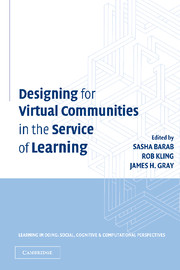Book contents
- Frontmatter
- Contents
- List of Contributors
- Series Foreword
- Foreword
- Preface and Acknowledgments
- In Memoriam
- PART I COMING TO TERMS WITH COMMUNITY
- PART II DESIGNING FOR WEB-SUPPORTED COMMUNITY
- 3 Designing System Dualities
- 4 Group Behavior and Learning in Electronic Forums
- 5 Teacher Professional Development, Technology, and Communities of Practice
- 6 Community of Practice
- PART III FOSTERING COMMUNITY/MEMBER PARTICIPATION
- PART IV RESEARCHING ONLINE COMMUNITY
- Index
- Titles in the series
- References
3 - Designing System Dualities
Characterizing an Online Professional Development Community
Published online by Cambridge University Press: 05 June 2012
- Frontmatter
- Contents
- List of Contributors
- Series Foreword
- Foreword
- Preface and Acknowledgments
- In Memoriam
- PART I COMING TO TERMS WITH COMMUNITY
- PART II DESIGNING FOR WEB-SUPPORTED COMMUNITY
- 3 Designing System Dualities
- 4 Group Behavior and Learning in Electronic Forums
- 5 Teacher Professional Development, Technology, and Communities of Practice
- 6 Community of Practice
- PART III FOSTERING COMMUNITY/MEMBER PARTICIPATION
- PART IV RESEARCHING ONLINE COMMUNITY
- Index
- Titles in the series
- References
Summary
The advent of cyberspace is apt to be seen in two ways, each of which can be regretted or welcomed, either as a new stage in the etherealization of the world we live in, the real world of people and things and places, or, conversely, as a new stage in the concretization of the world we dream and think in, the world of abstractions, memory and knowledge.
– Benedikt, 1991, p. 124The idea of “virtual communities” has captured popular, as well as scholarly, attention. Numerous websites and dot.com companies advertise their “online communities.” In hundreds of books and articles, virtual communities are championed by educators, cognitive scientists, sociologists, anthropologists, computer scientists, and even CEOs. This outpouring of interest takes place in an America that is increasingly concerned about the loss of face-to-face community (Putnam, 2001). Advocates of online communities hope that by leveraging technology, they can recreate a “we” that has steadily eroded into many isolated “I's.” There is confusion, though, about the definition of a virtual community, which includes anything from a tight-knit group of people who share important parts of their lives on a day-to-day basis to an amorphous chat group that can be joined (and left) by anyone with a valid password. Many educators are participating in this movement as well, exploring the educational value of employing a “community” model for supporting learning. The idea is that through participating in a community, novices can learn through collaboration with others and by working alongside more experienced members.
- Type
- Chapter
- Information
- Publisher: Cambridge University PressPrint publication year: 2004
References
- 44
- Cited by



